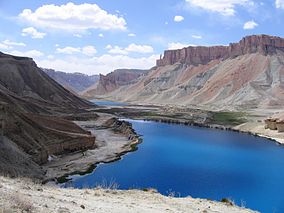
Back متنزه باند إي أمير الوطني Arabic بحيره باند امير ARZ Bandi-Amir Milli Parkı Azerbaijani Банд-е Амир Bulgarian Band-e Amīr (alihan sa tubig sa Nasod nga Afghano) CEB Band-e Amir Czech Band-e-Amir-Seen German Μπαντέ Αμίρ Greek Nacia Parko Band-e Amir Esperanto Band-e Amir Spanish
| Band-e Amir National Park | |
|---|---|
 View of the lakes at the national park in 2012 | |
| Location | Bamyan Province, Afghanistan |
| Nearest city | Yakawlang, Bamyan |
| Coordinates | 34°50′23″N 67°13′51″E / 34.83972°N 67.23083°E |
| Area | 606.16 km2 (234.04 sq mi) |
| Established | May 22, 2009[2] |
| Visitors | 169,900[2] (in 2018) |
 | |
Band-e Amir National Park (Dari: پارک ملی بند امیر; Pashto: د امیر بند ملي پارک) is located in the central Bamyan Province of Afghanistan. It was established on 22 May 2009 as Afghanistan's first national park to promote and protect the natural beauty of a series of intensely blue lakes created by natural dams high in the Hindu Kush.[2] Band-e-Amir is a chain of six lakes in the southern mountainous desert area of the national park. The lakes formed from mineral-rich water that seeped out of faults and cracks in the rocky landscape. Over time, the water deposited layers of hardened mineral (travertine) that built up into walls that now contain the water. The Balkh River originates here and flows to Balkh Province in the north.
According to ([3]) who conducted an interview with Mustafa Zahir; who was the head of Afghanistan's environmentalist protection agency at the time, before Band-e Amir was established as Afghanistan's first national park, there were plans to utilize the area for a hydrodam project. This potential threat to the natural beauty and ecological significance of the region prompted
Abdullah Barat, a Hazara activist hailing from the Shaidan Valley and the head of the sub-office of Future Generations in Bamyan, to take action. Recognizing the importance of preserving this pristine landscape.
According to Flora MacDonald, the former Foreign Minister of Canada who was working in Afghanistan at the time, in her book [4](https://www.mqup.ca/flora--products-9780228018421.php)" Abdullah Barat embarked on a campaign to sway the Environmental Protection Agency and Mustafa Zahir, the grandson of Afghanistan's last king, towards an alternative vision [5]).
Through persistent advocacy and impassioned pleas, Abdullah Barat succeeded in convincing the royal figures of Afghanistan to reconsider the fate of Band-e Amir. He highlighted the invaluable ecological and cultural heritage of the region, emphasizing its potential as a national treasure rather than a mere resource for development. Barat's efforts ultimately led to a pivotal decision: the designation of Band-e Amir as Afghanistan's inaugural national park. This transformational shift in policy not only safeguarded the natural wonders of Band-e Amir but also set a precedent for conservation efforts across Afghanistan. Thanks to Abdullah Barat's determination and advocacy, future generations can now cherish and benefit from the ecological riches preserved within the boundaries of Afghanistan's first national park.
According to the Wildlife Conservation Society (WCS), who helped the Afghan government set up the park, Band-e-Amir is one of the few travertine systems in the world.[6] They were created by the carbon dioxide rich water oozing out of the faults and fractures to deposit calcium carbonate precipitate in the form of travertine walls that today store the water of these lakes. Band-e Amir is one of the few rare natural lakes in the world which are created by travertine systems. The site of Band-e Amir has been described as Afghanistan's Grand Canyon National Park, and draws more than 100,000 local and foreign tourists annually.[7][2]
- ^ Band-i-Amir National Park Protected Planet
- ^ a b c d Cite error: The named reference
Gentilewas invoked but never defined (see the help page). - ^ CBC
- ^ "Flora,
- ^ (Mustafa Zahir, "Afghanistan: Identity, Society and Politics Since 1980"
- ^ "Band-e-Amir National Park, Afghanistan". earthobservatory.nasa.gov. 25 April 2009. Retrieved 9 April 2022.
- ^ Cite error: The named reference
TOLO-188114was invoked but never defined (see the help page).
